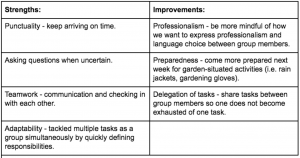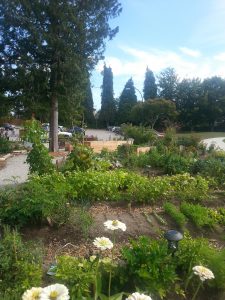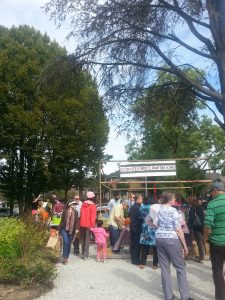It feels like a long time has passed since our last posting. The growing season has wrapped up in Riley Park, and it seems that our work on the produce library is coming to a close. Since the last blog post, we have drafted a survey for the Little Mountain Neighbourhood House, which will be used to gather information on people’s opinions of the events at Riley Park and ideas on how the garden could be improved. The produce library is completely built now, but we have realized that we will not be able to reach our goal of animating it with the amount of time we have left in our course.

(Riley Park Community Garden, 2017)
This realization has been a moment of significance for us. We have developed some ideas about the animation, but we have not had the opportunity to come together and implement the plan; doing so would require knowledge of what will happen in the garden over the next few months. For example, we would like to create laminated information cards that detail nutritional information of the food to be placed inside the produce library. However, we do not yet know who will be supplying the food, nor what kinds of foods will specifically be in there. We also wanted to note a few ways this food could be prepared. Once we created these laminated information cards, we wanted to place them inside a little wooden holder that could be attached to the produce library. This process would probably take us another couple of weeks. However, with the term coming to a close, we do not think this will be accomplished. The building of the produce library itself took up a lot of the term.
Because the produce library is not fully animated, we will not be able to really see its effect on the community. We can only predict and talk about the expected outcome. This is not ideal, but much more work and research must be done before we can animate the library in a way that is effective and useful. We do not want to do it hastily without fully spending the time to consult with people in the neighbourhood. What we learned during this project was that it takes much longer to get things done when trying to take into account many different ideas and potential directions. Even during the initial placement of the produce library, we encountered uncertainty about where exactly it should be situated. After digging the holes for the structure – nearly two feet deep through rocky earth and clay – we found out that the community members had not reached a consensus on its location. This meant that we took a lot longer to do things than predicted, which was an important learning experience. As well, we will not be able to distribute the surveys ourselves and see the results. We hope the information in the surveys would give us more insight about how to animate the library appropriately. Although there is still a lot more to do with our produce library, we believe this experience was helpful in meeting our learning objectives. For example, we had to deeply think between the connections of food, health and the environment on a local level while at Riley Park, even though we did not meet all our project goals.
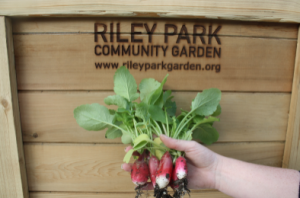
(Riley Park Community Garden, 2017)
From here, we hope to outline a plan for future directions, which we hope will be useful for anyone who will be continuing the project. We will provide as much information as possible, and perhaps convey some challenges we faced. Hopefully, some results from the survey we produced will be released, and will serve to help the next group approach the project. There is uncertainty with the future of the produce library; we did not get the city’s approval on the placement of the library, and so it may not be able to stay in the garden. Even so, our work on the project allowed us to learn a lot about working within the community and with others. Moving forward, we would also like to see a shift towards more of a capacity building mindset within the group – a perspective that would have been useful in the beginning of the term. A capacity building mindset would have allowed us to realize the importance of community knowledge and experts earlier. We did not meet our full potential in this project; however, upon reflection we have identified where there is room for improvement.
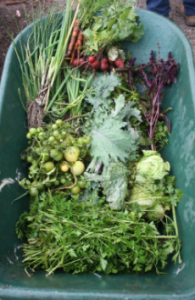
(Riley Park Community Garden, 2017)
References:
Riley Park Community Garden. (2017). Harvest Party + Riley Park Through the Ages: The
Recap! Retrieved by https://www.rileyparkgarden.org/news/2017/10/23/riley-park-through-the-ages-a-recap

